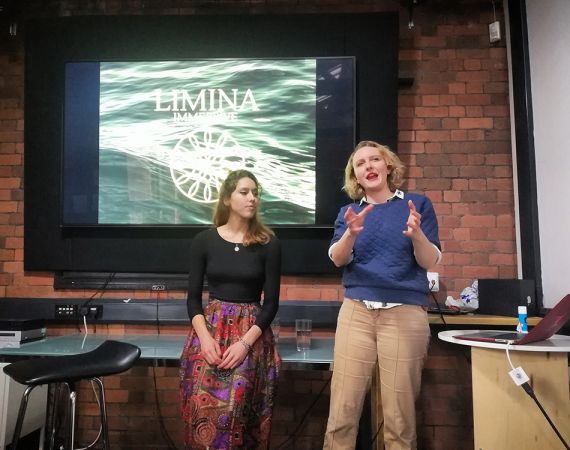Lunchtime talk write-up
Posted on Tue 16 Jan 2018
Limina Immersive
Reflecting on their VR research events over last 6 months, Catherine Allen and Emma Hughes have been bringing VR to broader audiences.

Posted by
In 2017 we co-produced two experimental VR events at Watershed with Studio residents Catherine Allen and Emma Hughes . In this Lunchtime Talk, they reflected on their VR research events over last 6 months and how they bring VR to broader audiences, taking their approach to Cambridge, London, Watershed VR Sessions and the biggest event to date, the Limina VR Weekender. Limina Immersive curate VR arts events that treat VR as an artistic medium rather than a gimmick. Their aim is to create a positive and healthy industry, taking it out of less accesible spaces and instead, to wider audiences.
Five Things I Learned:
1. Catherine’s background is in theatre and computers, but she didn’t have the opportunity to bring these two passions together until she produced two VR films with the BBC, Easter Rising: Voice of a Rebel and No Small Talk. She found that without physically taking the experience out into public events, it wasn’t getting to the right audiences. What was the point of creating VR content, when most of the population don’t own headsets? Before joining Limina earlier this year, Emma has interned with Splash and Ripple, worked with female film-makers through the From Her Point of View programme at KWMC, was a marketing intern with Oxfam and has worked with Wyldwood Arts.
2. Statistics show that there is already a gender gap, 13% of adult women in the UK have tried VR compared to 20% of men. Although there isn’t more data available on demography or class currently, Catherine predicts that BAME (Black, Asian and Minority Ethnic) users will be lower than their white counterparts and wealthier people are more likely to be early adopters due to headsets being expensive. Emma is interested in the fresh perspective Limina is bringing to VR; stats from the VR weekender revealed that the audience was 54% female to 45% male with a diverse range of ages, not just teens or young people.
3. Limina are intersted in positioning VR as a communal arts experience. There is no habit or set premise for experiencing VR at the moment and Limina want to create this framework for audiences. The Limina VR Weekender programme varied from narrative-driven experiences to more experimental pieces, grouped together into different strands. Each strand had two or three different VR experiences that shared a particular theme, such as childhood, surrealism and nature.
4. The team make careful decisions about the set up of a space for VR, the wording of the host's script and the ratio of staff to audience, to help support the audience through the experience. It’s a huge ask to expect the user to give away their sense of sight and sound as they use a headset, so it’s important to make it as safe and cosy for them as possible. Emma explained that she doesn’t want people to be put off by one bad VR experience and to dismiss the whole medium. Most of their audience were new to VR and 80% said they were very comfortable in Limina's feedback form. This stat has grown with each experience from Cambridge onwards and 84% of people would recommend the experience to a friend.
5. Catherine and Emma enjoyed hearing feedback from the audience after the sessions, in fact they learned audience members enjoyed the Q&A and group discussions after the VR sessions just as much as the VR experience! There was a huge amount of positive feedback on the dressing of the room and atmosphere and having a ‘VR guide’ made them feel at ease, even those who haven’t done VR before.
What the Limina team VR sessions in June is that the way you position VR is extremely important. After 46 screenings, with six people in each, each with a Q&A after they found people increasingly say that they come for the content rather than the tech.
You can find out about upcoming Limina events by following Catherine and Emma on Twitter or visiting www.liminaimmersive.com
